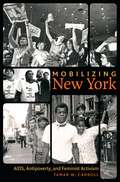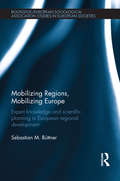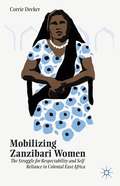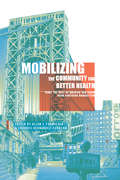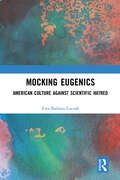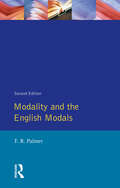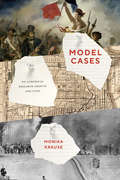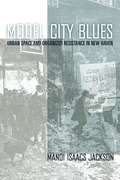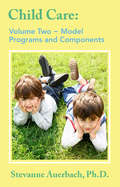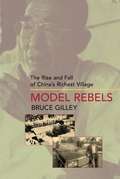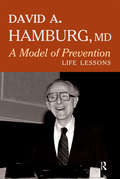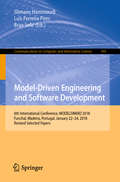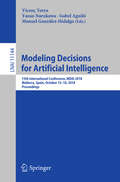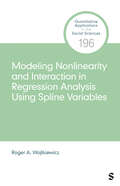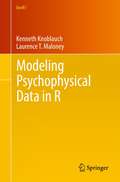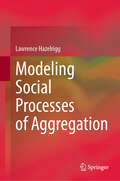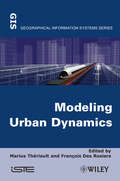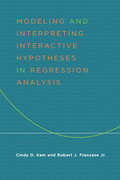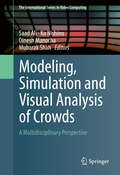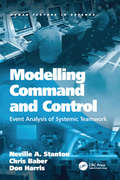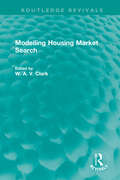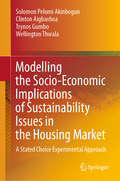- Table View
- List View
Mobilizing New York
by Tamar W. CarrollExamining three interconnected case studies, Tamar Carroll powerfully demonstrates the ability of grassroots community activism to bridge racial and cultural differences and effect social change. Drawing on a rich array of oral histories, archival records, newspapers, films, and photographs from post-World War II New York City, Carroll shows how poor people transformed the antipoverty organization Mobilization for Youth and shaped the subsequent War on Poverty. Highlighting the little-known National Congress of Neighborhood Women, she reveals the significant participation of working-class white ethnic women and women of color in New York City's feminist activism. Finally, Carroll traces the partnership between the AIDS Coalition to Unleash Power (ACT UP) and Women's Health Action Mobilization (WHAM!), showing how gay men and feminists collaborated to create a supportive community for those affected by the AIDS epidemic, to improve health care, and to oppose homophobia and misogyny during the culture wars of the 1980s and 1990s. Carroll contends that social policies that encourage the political mobilization of marginalized groups and foster coalitions across identity differences are the most effective means of solving social problems and realizing democracy.
Mobilizing Regions, Mobilizing Europe: Expert Knowledge and Scientific Planning in European Regional Development (Studies in European Sociology)
by Sebastian M. BuettnerRegional development strategies are becoming more similar all around Europe, even though regional differences are more pronounced than ever and many European regions have become more autonomous actors. This thesis of a peculiar standardized diversification of sub-national space in the modern European Union is the point of departure of this book. Based upon the analytical premises of Stanford School Sociological Institutionalism, Sebastian M. Büttner studies regional mobilization in contemporary Europe from a new and innovative perspective. He highlights the importance of scientific expertise and global scientific models in contemporary regional development practice, and exemplifies their significance with the example of region-building in Poland in the course of EU integration. This new wave of regional mobilization is not just conceived as an effect of local, national or European politics, but as an expression of a larger conceptual shift in governing society and space. This well researched and clearly argued book not only provides fresh insights into region-building and regionalization in contemporary European space, but also contributes to the new sociology of Europeanization. It will be an illuminating read for scholars and students in Sociology, European and EU studies, International Relations, Cultural Studies, Geography, Regional Science, Polish Studies and related subject areas.
Mobilizing Zanzibari Women
by Corrie DeckerThe experiences of African women in the era before independence remain a woefully understudied facet of African history. This innovative and carefully argued study thus adds tremendously to our understanding of colonial history by focusing on women's education, professionalization, and political mobilization in the East African islands of Zanzibar.
Mobilizing for Development: The Modernization of Rural East Asia
by Kristen E. LooneyMobilizing for Development tackles the question of how countries achieve rural development and offers a new way of thinking about East Asia's political economy that challenges the developmental state paradigm. Through a comparison of Taiwan (1950s–1970s), South Korea (1950s–1970s), and China (1980s–2000s), Kristen E. Looney shows that different types of development outcomes—improvements in agricultural production, rural living standards, and the village environment—were realized to different degrees, at different times, and in different ways. She argues that rural modernization campaigns, defined as policies demanding high levels of mobilization to effect dramatic change, played a central role in the region and that divergent development outcomes can be attributed to the interplay between campaigns and institutions. The analysis departs from common portrayals of the developmental state as wholly technocratic and demonstrates that rural development was not just a byproduct of industrialization. Looney's research is based on several years of fieldwork in Asia and makes a unique contribution by systematically comparing China's development experience with other countries. Relevant to political science, economic history, rural sociology, and Asian Studies, the book enriches our understanding of state-led development and agrarian change.
Mobilizing the Community for Better Health: What the Rest of America Can Learn from Northern Manhattan
by Lourdes Hernandez-Cordero Eds. Formicola AllanFrom 1999 to 2009, The Northern Manhattan Community Voices Collaborative put Columbia University and its Medical Center in touch with surrounding community organizations and churches to facilitate access to primary care, nutritional improvement, and smoking cessation, and to broker innovative ways to access healthcare and other social services. This unlikely partnership and the relationships it forged reaffirms the wisdom of joining "town and gown" to improve a community's well-being.Staff members of participating organizations have coauthored this volume, which shares the successes, failures, and obstacles of implementing a vast community health program. A representative of Alianza Dominicana, for example, one of the country's largest groups settling new immigrants, speaks to the value of community-based organizations in ridding a neighborhood of crime, facilitating access to health insurance, and navigating the healthcare system. The editors outline the beginnings and infrastructure of the collaboration and the relationship between leaders that fueled positive outcomes. Their portrait demonstrates how grassroots solutions can create productive dialogues that help resolve difficult issues.
Mocking Eugenics: American Culture against Scientific Hatred
by Ewa Barbara LuczakMocking Eugenics explores the opposition to eugenic discourse mounted by twentieth-century American artists seeking to challenge and destabilize what they viewed as a dangerous body of thought. Focusing on their wielding of humor to attack the contemporaneous science of heredity and the totalitarian impulse informing it, this book confronts the conflict between eugenic theories presented as grounded in scientific and metaphysical truth and the satirical treatment of eugenics as not only absurdly illogical but also antithetical to democratic ideals and inimical to humanistic values. Through analyses of the films of Charlie Chaplin and the fiction of F. Scott Fitzgerald, Ernest Hemingway, Anita Loos, and Wallace Thurman, Mocking Eugenics examines their use of laughter to dismantle the rhetoric of perfectionism, white supremacy, and nativism that shaped mainstream expressions of American patriotism and normative white masculinity. As such, it will appeal to scholars of cultural studies, literature, cinema, sociology, humor, and American studies.
Modality and the English Modals (Longman Linguistics Library)
by F. R. PalmerA detailed account of the many uses and functions of these verbs. The nature of modality, and some controversial issues, are also discussed.
Mode & Musik
by Jochen SträhleDieses Buch wird das Verständnis der Leser für die Verbindungen zwischen der Musik- und der Modeindustrie erweitern. Es hebt die Herausforderungen hervor, denen sich die Modeindustrie derzeit in Bezug auf den Hyperwettbewerb, die Definition immer schnellerer Trends, sich ändernde Verbraucherwünsche usw. gegenübersieht. Die Modeindustrie wird in der Tat stark von der digitalen Revolution in der Musikindustrie beeinflusst, die das Gesicht des individuellen Musikkonsums und des sozialen Bezugs verändert hat und sich daher auch auf den Modekonsum und den sozialen Bezug auswirkt. Dieses Verständnis ist von entscheidender Bedeutung, um die Strategien eines Modeunternehmens auf die Anforderungen der modernen Modekonsumenten auszurichten. Inhaltlich befasst sich das Buch zunächst mit der sozialen Perspektive von Mode und Musik. Dazu gehört eine Analyse der Musik als wichtiger Einflussfaktor für Modetrends, sowohl theoretisch als auch anhand einer Fallstudie über Grunge-Musik. Anschließend wird die Rolle der Musik in der Modebranche behandelt, wobei die Musik in den Geschäften und die Rolle der Musik in der Modekommunikation behandelt werden. Im Anschluss daran wird die Rolle der Mode im Musikgeschäft analysiert. Dazu gehören der Trend zum Co-Design von Modekollektionen, die Rolle von Musikkünstlern bei der Differenzierung nach Stilrichtungen und der Markt für Musik-Mode-Merchandise-Artikel (sowohl theoretisch als auch anhand einer Fallstudie). Abschließend werden mögliche Lehren aus der Musikindustrie für die Modeindustrie gezogen. Dazu gehört auch eine Analyse der digitalen Revolution und des Aufkommens der Crowdfunding-Idee (sowohl theoretisch als auch in einer Fallstudie).
Model Cases: On Canonical Research Objects and Sites
by Monika KrauseIn Model Cases, Monika Krause asks about the concrete material research objects behind shared conversations about classes of objects, periods, and regions in the social sciences and humanities. It is well known that biologists focus on particular organisms, such as mice, fruit flies, or particular viruses when they study general questions about life, development, and disease. Krause shows that scholars in the social sciences and humanities also draw on some cases more than others, selecting research objects influenced by a range of ideological but also mundane factors, such as convenience, historicist ideas about development over time, schemas in the general population, and schemas particular to specific scholarly communities. Some research objects are studied repeatedly and shape our understanding of more general ideas in disproportionate ways: The French Revolution has profoundly influenced our concepts of revolution, of citizenship, and of political modernity, just like studies of doctors have set the agenda for research on the professions. Based on an extensive analysis of the role of model cases in different fields, Krause argues that they can be useful for scholarly communities if they are acknowledged and reflected as particular objects; she also highlights the importance of research strategies based on neglected research objects and neglected combinations of research objects and scholarly concerns.
Model City Blues: Urban Space and Organized Resistance in New Haven
by Mandi Isaacs JacksonModel City Blues tells the story of how regular people, facing a changing city landscape, fought for their own model of the "ideal city" by creating grassroots plans for urban renewal. Filled with vivid descriptions of significant moments in a protracted struggle, it offers a street-level account of organized resistance to institutional plans to transform New Haven, Connecticut in the 1960s. Anchored in the physical spaces and political struggles of the city, it brings back to center stage the individuals and groups who demanded that their voices be heard. By reexamining the converging class- and race-based movements of 1960s New Haven, Mandi Jackson helps to explain the city's present-day economic and political struggles. More broadly, by closely analyzing particular sites of resistance in New Haven, Model City Blues employs multiple academic disciplines to redefine and reimagine the roles of everyday city spaces in building social movements and creating urban landscapes.
Model Programs and Their Components
by James A Rivaldo Ph.D. Stevanne AuerbachModel Programs and Components focuses on the planning and implementation of model programs and presents necessary steps to achieve a comprehensive and practical service to the community including health, food, social, and psychological services and documents local experiences in Appalachia, California, Colorado and Oregon. Foreword by Congressman John Brademas, former President of New York University. Contributors include James A. Levine, Helen L. Gordon, Jean H. Berman, Kathleen B. Latham, Kay Martin, Mary Millman, Mary W.Vlack, Ramon D. Blatt, Paul T. Barnes, Dr. Ann De Huff Peters, Dr. Susan S Aronson, Marilyn Chow, Dorothy N. Shack, David Brown, Keith R. Alward, Linda Regele-Sinclair, Christoph M, Heinicke, Dr. David Friedman, Dr. Elizabeth Prescott, Conchita Puncel, and June Solnit Sale.
Model Rebels: The Rise and Fall of China's Richest Village
by Bruce GilleyThis narrative about rural life and development in post-Mao China which also engages a scholarly political science debate about the reasons for political resistance.
Model of Prevention: Life Lessons
by David A. HamburgAn autobiography of a ground-breaking medical doctor. Dr. David A. Hamburg started as a medical student with interest in stress disorders, paying special attention to the propensity toward violence, including the evolution of human aggression. This lead him on a path to becoming one of the most highly celebrated doctors in America - he was a member of President Clinton's Committee of Advisors on Science and Technology and was awarded the Presidential Medal of Freedom (the highest civilian award of the United States). Most recently, he chaired committees at the United Nations and European Union on the prevention of genocide. This book will be inspirational for emerging scientists today.
Model-Driven Engineering and Software Development: 6th International Conference, MODELSWARD 2018, Funchal, Madeira, Portugal, January 22-24, 2018, Revised Selected Papers (Communications in Computer and Information Science #991)
by Slimane Hammoudi Luís Ferreira Pires Bran SelicThis book constitutes thoroughly revised and selected papers from the 6th International Conference on Model-Driven Engineering and Software Development, MODELSWARD 2018, held in Funchal, Madeira, Portugal, in January 2018. The 22 thoroughly revised and extended papers presented in this volume were carefully reviewed and selected from 101 submissions. They contribute to the development of highly relevant research trends in model-driven engineering and software development such as innovative methods for MDD-based development and testing of web-based applications and user interfaces, support for development of Domain-Specific Languages (DSLs), MDD-based application development on multiprocessor platforms, advances in MDD tooling, formal semantics and behaviour modelling, and MDD-based product-line engineering.
Modeling Decisions for Artificial Intelligence: 15th International Conference, MDAI 2018, Mallorca, Spain, October 15–18, 2018, Proceedings (Lecture Notes in Computer Science #11144)
by Vicenç Torra Yasuo Narukawa Isabel Aguiló Manuel González-HidalgoThis book constitutes the proceedings of the 15th International Conference on Modeling Decisions for Artificial Intelligence, MDAI 2018, held in Mallorca, Spain, in October 2018.The 24 papers presented in this volume were carefully reviewed and selected from 43 submissions. The book also contains one invited talk in full paper length. The papers were organized in topical sections named: aggregation operators, fuzzy measures and integrals; decision making; clustering and classification; and data privacy and security.
Modeling Nonlinearity and Interaction in Regression Analysis Using Spline Variables (Quantitative Applications in the Social Sciences)
by Roger A. Wojtkiewicz"Spline variables and their interactions play a crucial role in the field of social science. This book offers a comprehensive and detailed exploration of this method, providing valuable insights and information for researchers in the field." --Man-Kit Lei, The University of Georgia This volume addresses the issue of linear constraints in regression modeling. Author Roger A. Wojtkiewicz uses the method of knotted spline variables (also known as piecewise linear regression) and a new method involving group spline variables to model nonlinearity in a variety of situations. Using spline variables to model nonlinearity allows researchers to specify unrestricted models for models that involve interval variables, allowing for greater flexibility in modeling any possible interaction.
Modeling Nonlinearity and Interaction in Regression Analysis Using Spline Variables (Quantitative Applications in the Social Sciences)
by Roger A. Wojtkiewicz"Spline variables and their interactions play a crucial role in the field of social science. This book offers a comprehensive and detailed exploration of this method, providing valuable insights and information for researchers in the field." --Man-Kit Lei, The University of Georgia This volume addresses the issue of linear constraints in regression modeling. Author Roger A. Wojtkiewicz uses the method of knotted spline variables (also known as piecewise linear regression) and a new method involving group spline variables to model nonlinearity in a variety of situations. Using spline variables to model nonlinearity allows researchers to specify unrestricted models for models that involve interval variables, allowing for greater flexibility in modeling any possible interaction.
Modeling Psychophysical Data in R
by Laurence T. Maloney Kenneth KnoblauchMany of the commonly used methods for modeling and fitting psychophysical data are special cases of statistical procedures of great power and generality, notably the Generalized Linear Model (GLM). This book illustrates how to fit data from a variety of psychophysical paradigms using modern statistical methods and the statistical language R. The paradigms include signal detection theory, psychometric function fitting, classification images and more. In two chapters, recently developed methods for scaling appearance, maximum likelihood difference scaling and maximum likelihood conjoint measurement are examined. The authors also consider the application of mixed-effects models to psychophysical data. R is an open-source programming language that is widely used by statisticians and is seeing enormous growth in its application to data in all fields. It is interactive, containing many powerful facilities for optimization, model evaluation, model selection, and graphical display of data. The reader who fits data in R can readily make use of these methods. The researcher who uses R to fit and model his data has access to most recently developed statistical methods. This book does not assume that the reader is familiar with R, and a little experience with any programming language is all that is needed to appreciate this book. There are large numbers of examples of R in the text and the source code for all examples is available in an R package MPDiR available through R. Kenneth Knoblauch is a researcher in the Department of Integrative Neurosciences in Inserm Unit 846, The Stem Cell and Brain Research Institute and associated with the University Claude Bernard, Lyon 1, in France. Laurence T. Maloney is Professor of Psychology and Neural Science at New York University. His research focusses on applications of mathematical models to perception, motor control and decision making.
Modeling Social Processes of Aggregation
by Lawrence HazelriggThis book demonstrates, via formal statements and empirical illustrations, that nonlinearities in social processes can be modeled systematically to create solutions with practical applications in the institutional forms of paid employment, schooling, and familial relations including marital and kinship ties and the rearing of children. It shows how social processes can be modeled accurately through analyzing time series data—specifically, a temporal sequence of process outcomes that is dense enough in observation time to support appropriate techniques of modeling the outcome sequence. The book illustrates techniques using minimal mathematical formalism which is explained also in careful narrative descriptions of the model logic.
Modeling Urban Dynamics: Mobility, Accessibility and Real Estate Value
by François Des Rosiers Marius ThériaultThe field of Urban Dynamics itself is based on the systems engineering concept that all complex systems (and cities and urban areas are no exception) are comprised of independent and often smaller, more understandable sub-components with relationships to one another. This allows for the system as a whole to be modeled, using knowledge of the individual subsystems and their behaviors. In this instance, urban dynamics allows for the modeling and understanding of land use, the attractiveness of space to residents, and how the ageing and obsolescence of buildings affects planning and economic development, as well as population movements, with the urban landscape. The book adopts a trans-disciplinary approach that looks at the way residential mobility, commuting patterns, and travel behavior affect the urban form. It addresses a series of issues dealing with the accessibility of urban amenities, quality of life, and assessment of landscape residential choices, as well as measurement of external factors in the urban environment and their impact on property values.
Modeling and Interpreting Interactive Hypotheses in Regression Analysis
by Cindy D. Kam Robert J. Franzese Jr.Social scientists study complex phenomena about which they often propose intricate hypotheses tested with linear-interactive or multiplicative terms. While interaction terms are hardly new to social science research, researchers have yet to develop a common methodology for using and interpreting them. Modeling and Interpreting Interactive Hypotheses in Regression Analysisprovides step-by-step guidance on how to connect substantive theories to statistical models and how to interpret and present the results. "Kam and Franzese is a must-have for all empirical social scientists interested in teasing out the complexities of their data. " ---Janet M. Box-Steffensmeier, Ohio State University "Kam and Franzese have written what will become the definitive source on dealing with interaction terms and testing interactive hypotheses. It will serve as the standard reference for political scientists and will be one of those books that everyone will turn to when helping our students or doing our work. But more than that, this book is the best text I have seen for getting students to really think about the importance of careful specification and testing of their hypotheses. " ---David A. M. Peterson, Texas A&M University "Kam and Franzese have given scholars and teachers of regression models something they've needed for years: a clear, concise guide to understanding multiplicative interactions. Motivated by real substantive examples and packed with valuable examples and graphs, their book belongs on the shelf of every working social scientist. " ---Christopher Zorn, University of South Carolina "Kam and Franzese make it easy to model what good researchers have known for a long time: many important and interesting causal effects depend on the presence of other conditions. Their book shows how to explore interactive hypotheses in your own research and how to present your results. The book is straightforward yet technically sophisticated. There are no more excuses for misunderstanding, misrepresenting, or simply missing out on interaction effects!" ---Andrew Gould, University of Notre Dame Cindy D. Kam is Assistant Professor, Department of Political Science, University of California, Davis. Robert J. Franzese Jr. is Associate Professor, Department of Political Science, University of Michigan, and Research Associate Professor, Center for Political Studies, Institute for Social Research, University of Michigan. For datasets, syntax, and worksheets to help readers work through the examples covered in the book, visit: www. press. umich. edu/KamFranzese/Interactions. html
Modeling, Simulation and Visual Analysis of Crowds
by Mubarak Shah Saad Ali Ko Nishino Dinesh ManochaOver the last several years there has been a growing interest in developing computational methodologies for modeling and analyzing movements and behaviors of 'crowds' of people. This interest spans several scientific areas that includes Computer Vision, Computer Graphics, and Pedestrian Evacuation Dynamics. Despite the fact that these different scientific fields are trying to model the same physical entity (i. e. a crowd of people), research ideas have evolved independently. As a result each discipline has developed techniques and perspectives that are characteristically their own. The goal of this book is to provide the readers a comprehensive map towards the common goal of better analyzing and synthesizing the pedestrian movement in dense, heterogeneous crowds. The book is organized into different parts that consolidate various aspects of research towards this common goal, namely the modeling, simulation, and visual analysis of crowds. Through this book, readers will see the common ideas and vision as well as the different challenges and techniques, that will stimulate novel approaches to fully grasping "crowds. "
Modelling Command and Control: Event Analysis of Systemic Teamwork (Human Factors in Defence)
by Neville A. Stanton Chris BaberSince its inception, just after the Second World War, Human Factors research has paid special attention to the issues surrounding human control of systems. Command and control environments continue to represent a challenging domain for human factors research. Modelling Command and Control takes a broad view of command and control research, to include C2 (command and control), C3 (command, control and communication), and C4 (command, control, communication and computers) as well as human supervisory control paradigms. The book presents case studies in diverse military applications (for example, land, sea and air) of command and control. The book explores the differences and similarities in the land, sea and air domains; the theoretical and methodological developments, approaches to system and interface design, and the workload and situation awareness issues involved. It places the role of humans as central and distinct from other aspects of the system. Using extensive case study material, Modelling Command and Control demonstrates how the social and technical domains interact, and why each require equal treatment and importance in the future.
Modelling Housing Market Search (Routledge Revivals)
by W. A. V. ClarkOriginally published in 1982, this book contains research in the area of econometric modelling in the housing market, including that which has extended to the use of search models. The subjects covered include the importance of racial differences, spatial aspects of residential search and information provision and its effect on the behaviour of the buyers. The combination of careful analytic modelling, empirical testing and speculative discussions of the role of agents in the search process provides an innovative and imaginative approach to the interesting problems of understanding the individual behaviour in complex contexts such as the urban housing market.
Modelling the Socio-Economic Implications of Sustainability Issues in the Housing Market: A Stated Choice Experimental Approach
by Clinton Aigbavboa Wellington Thwala Solomon Pelumi Akinbogun Trynos GumboThis book discusses sustainable housing issues in urban areas throughout the Global South, revealing their complexity in terms of urban dynamics, housing markets and human interactions with the environment. Its main focus is on the location of graves within private residences, cemeteries in the immediate vicinity of private residences, and the implications of these factors for renters’ choices and rents. The book addresses the economics of land use for graves in connection with housing choices and the implications for the rented sector of the property market. By means of several model-based simulations, it demonstrates that the neoclassical economics remedy to the negative externality of graves in or near private residences remains generally unacceptable. Providing readers with a clear understanding of tenants’ priorities in their choice of housing, as well as a new approach to the negative externality of graves in the rented sector, the book will be of interest to policymakers, urban planners, investors in residential housing and land economists alike.
